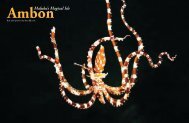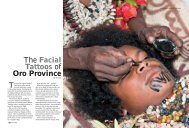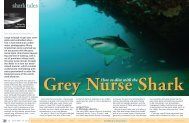Rapid Ecological Assessment - Indo-Pacific Images
Rapid Ecological Assessment - Indo-Pacific Images
Rapid Ecological Assessment - Indo-Pacific Images
- No tags were found...
You also want an ePaper? Increase the reach of your titles
YUMPU automatically turns print PDFs into web optimized ePapers that Google loves.
Chapter 1 – Executive Summary<br />
The goal of the REA was to identify potential conservation targets, sites, and to recommended strategies by<br />
building on previous studies and assessments and indigenous knowledge. To achieve this goal, the REA team<br />
sought the objectives listed in Table 1.<br />
Table 1. Objectives of the <strong>Rapid</strong> <strong>Ecological</strong><strong>Assessment</strong> in Raja Ampat<br />
OBJECTIVE<br />
Complement and<br />
complete existing data<br />
on marine biodiversity<br />
and ecosystem<br />
condition.<br />
Determine and map<br />
vegetation types and<br />
condition, including<br />
biodiversity indicators<br />
and species of special<br />
interest.<br />
Implement socioeconomic<br />
assessments,<br />
including:<br />
Recommend priority<br />
conservation actions.<br />
ACTION<br />
• Implement assessments around Salawati, southwestern Fam, and south and west<br />
Kawe Islands<br />
• Implement comprehensive assessments at Misool (particularly the southeastern<br />
area) and eastern Wayag Islands<br />
• Generate data on sea turtles and dugongs, including species occurrence,<br />
distribution, status, threats and uses through direct observation and community<br />
consultations<br />
• Record seabird and cetacean occurrence and activities, especially evidence of<br />
seabird nesting<br />
• Document coral bleaching and identify resistant sites and correlation with<br />
resistance factors if relevant.<br />
• Collect quantitative and qualitative data on forest type and species<br />
• Implement general assessment of forest condition and frequency assessments of<br />
species of interest<br />
• Identify specific conservation assets<br />
• Determine uses of and threats to forest communities<br />
• Determine forest conservation needs, opportunities, and possible approaches.<br />
• Uses and degree of dependence on different resources, marine and terrestrial<br />
• Extent of immigrant (non-Papuan) activities and their impacts on coral reefs and<br />
other marine resources<br />
• Traditional user rights, customary land/sea tenure and participatory mapping of<br />
areas of perceived traditional ownership<br />
• Customary laws and practices governing resource use and control mechanisms<br />
(e.g., sasi gereja).<br />
• Assess value, condition, and conservation needs of existing MPAs and include or<br />
exclude from recommended network of sites<br />
• Identify potential new conservation sites<br />
• Identify conservation targets based on conservation value, measures of viability<br />
(including prospects for long-term survival, threat status and opportunities)<br />
• Identify priority conservation strategies and actions for follow-up, including<br />
activities to:<br />
! Strengthen management of existing sites<br />
! Establish new conservation areas<br />
! Engage communities and local government in conservation planning<br />
and action<br />
! Approach and process the establishment of a cluster of resilient and<br />
mutually replenishing MPA sites.<br />
1.2 Methodology<br />
Site selection for the REA involved a pre-survey analysis of nautical charts, existing literature and satellite<br />
images (cf. Appendix 7) to give a broad cross-section of marine habitats (fringing reefs, drop-offs, lagoon<br />
reefs, etc.) and to complement rather than duplicate existing studies. Logistical considerations, including<br />
10





